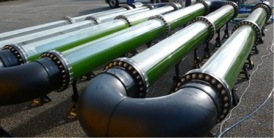
Algae Biodiesel: First Industrial Algae Plants Go Online
AlgaeLink has developed the first made-to-order industrial algae production facility in the world.
By Clayton B. Cornell • November 13, 2007
“Sure, we’ve all read 50 stories about algae biodiesel the panacea—the only biofuel that will make a serious dent in petroleum usage—but none of those stories have materialized yet. But the fact that commercially harvesting algae could produce yields of 10,000 gallons of oil per acre on agriculturally poor land has not been lost on green entrepreneurs. See my other posts on the topic here. While most of my coverage on algae biofuel research has focused on the United States, AlgaeLink N.V., based in the Netherlands, is the first company to market industrial algae production systems. The 5-year old company began selling units in the third quarter of 2007, after 4 years of investment and research.
How are AlgaeLink systems different?
Industry trend has primarily focused on development of closed bioreactors, most commonly an array of clear tubing that maximizes light and nutrient flow. In this model, algae is grown inside this transparent tubing with a constantly circulating supply of carbon dioxide and food. AlgaeLink’s design doesn’t seem much different than some of the other proposed systems I’ve already discussed: it’s based on 118 feet of 25 inch diameter tube fed by a water pump.
But several improvements make AlgaeLink unique, most notably the claim that they’ve solved the high-yield photoefficieny problem. As algae growth increases, the photobioreactor tubes get clogged with biomass, thereby reducing light that can penetrate into the center and reducing overall yield. AlgaeLink is currently patenting some mysterious technology that allows them to get around this.
Economically speaking, the company has also improved efficiency of transport and assembly of plant materials, along with creating proprietary sensing technology that can monitor algal growth from anywhere in the world. Such a sensing system would ostensibly allow the company to provide tech support from half a world away. The system is also self-cleaning, so no disassembly interrupts production.
AlgaeLink requires a demonstration plant for each potential site in order to optimize algal strain and test local climate conditions. Since AlgaeLink ships the reactors with 10 species of algae, there’s plenty room for experimentation.
How Much Does it Cost?
About $98,000 for the demonstration plant, which is required, and $821,000 to $14 million for different sized models.
You can also take a two-day algae production course in the Netherlands for $2,547.
You can also take a two-day algae production course in the Netherlands for $2,547.
Does it work?
Apparently, a demonstration plant is already running, producing about 2-4 kg of dry weight biomass per day. AlgaeLink claims yields of 10-100 TONS per day after 4-6 months of site monitoring to optimize algae strain based on local climate and water conditions. 10 tons is a lot more than 2-4 kg, so the scalability of the system must be incredible.
How much biodiesel is that?
I’m not really sure about that, but AlgaeLink has conducted an analysis on the suitability of producing algae biodiesel.
How much does the oil cost?
Cost of production varies by climate, but AlgaeLink claims their demonstration plant in the Netherlands is currently producing oil for 50 cents per gallon.
So why hasn’t anyone else made this technology available?
I’ll let the company’s president and CEO, Hans van de Ven, speak for himself:
We have a unique system and that’s the reason nobody else can offer it. They don’t know how to do it.
Someone needed to be first. We have put at least four years of work into our system. We have put a great deal of money into it and have had engineers and biologists working on it all over the world. We are ready to sell commercial plants. A lot of people over the Internet have been ripped off by people who promised a lot and nothing happened. We have a very good name in the industry and we would like to keep it like that.
